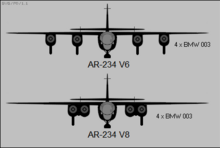|
Nacelle A nacelle (/nəˈsɛl/ nə-SEL) is a streamlined container for aircraft parts such as engines, fuel or equipment.[1] When attached entirely outside the airframe, it is sometimes called a pod, in which case it is attached with a pylon or strut and the engine is known as a podded engine.[2] In some cases—for instance in the typical "Farman" type "pusher" aircraft, or the World War II-era P-38 Lightning or SAAB J21—an aircraft cockpit may also be housed in a nacelle, rather than in a conventional fuselage. EtymologyLike many aviation terms, the word comes from French, in this case from a word for a small boat.[3] Development The Arado Ar 234 was one of the first operational jet aircraft with engines mounted in nacelles. During its development, the four engines had four distinct nacelles. They once had their own landing gear wheel, but they were later combined to two nacelles with two engines each. Around 2010, General Electric and NASA have developed nacelles with chevron-shaped trailing edges to reduce the engine noise of commercial aircraft, using an experimental Boeing 777 as a test platform.[4] Applications Usually, multi-engined aircraft use nacelles for housing the engines.[5] Combat aircraft (such as the Eurofighter Typhoon) usually have the engines mounted within the fuselage. Some engines are installed in the aircraft wing, as in the De Havilland Comet and Flying Wing type aircraft. Engines may be mounted in individual nacelles, or in the case of larger aircraft such as the Boeing B-52 Stratofortress (pictured right) may have two engines mounted in a single nacelle. Nacelles can be made fully or partially detachable for holding expendable resources such as fuel and armaments. Nacelles may be used to house equipment that will only function remote from the fuselage, for example the Boeing E-3 Sentry radar is housed in a nacelle called a radome.  Other uses
Design considerationsThe primary design issue with aircraft-mounted nacelles is streamlining to minimise drag so nacelles are mounted on slender pylons. This can cause issues with directing the needed conduits mounted within the nacelle to connect to the aircraft through such a narrow space. This is especially concerning with nacelles containing engines, as the fuel, and control, lines for multiple engine functions must all go through the pylons.[5] It is often necessary for nacelles to be asymmetrical, but aircraft designers try to keep asymmetrical elements to a minimum to reduce operator maintenance costs associated with having two sets of parts for either side of the aircraft.[5] References
|
Portal di Ensiklopedia Dunia